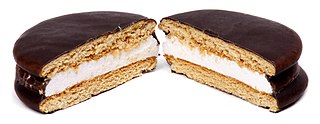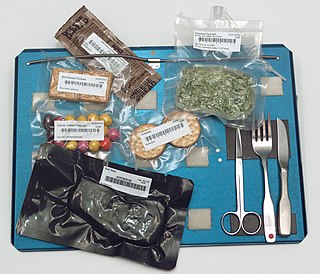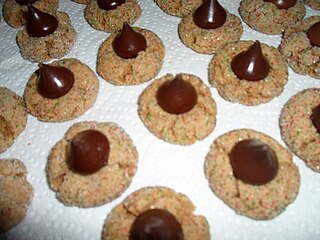Related Research Articles

A Moon Pie is an American snack, popular across much of the United States, which consists of two round graham cookies, with marshmallow filling in the center, dipped in a flavored coating. The snack is often associated with the cuisine of the American South, where they are traditionally accompanied by an RC Cola. Today, MoonPies are made by Chattanooga Bakery, Inc., in Chattanooga, Tennessee.

Pocky is a Japanese sweet snack food produced by the Ezaki Glico food company. Pocky was first sold in 1966, and was invented by Yoshiaki Koma. It consists of coated biscuit sticks. It was named after the Japanese onomatopoeic word pokkiri (ポッキリ), which is supposed to resemble the sound of the snack being cracked.

Cheerios is a brand of cereal manufactured by General Mills in the United States and Canada, consisting of pulverized oats in the shape of a solid torus. In some countries, including the United Kingdom, Cheerios is marketed by Cereal Partners under the Nestlé brand; in Australia and New Zealand, Cheerios is sold as an Uncle Tobys product. It was first manufactured in 1941 as CheeriOats.
Butterfinger is a candy bar manufactured by the Ferrara Candy Company, a subsidiary of Ferrero. It consists of a layered crisp peanut butter core covered in a chocolatey coating. It was invented by Otto Schnering of the Curtiss Candy Company in 1923. The name was chosen by a popularity contest.

Bamba is a snack made of peanut-butter-flavored puffed maize manufactured by the Osem corporation in Kiryat Gat, Israel. Bamba is one of the leading snack foods produced and sold in Israel. It was introduced in 1964. Bamba makes up 25% of the Israeli snack market.

Maxibon is a brand of ice cream sandwich made by Froneri. It consists of a block of ice cream containing small chocolate chips with one end covered in chocolate, and the other sandwiched between two biscuits.

Space food is a type of food product created and processed for consumption by astronauts during missions to outer space. The food has specific requirements to provide a balanced diet and adequate nutrition for individuals working in space while being easy and safe to store, prepare and consume in the machinery-filled weightless environments of crewed spacecraft. Most space food is freeze-dried to ensure long shelf life.
Flipz is a type of confectionery created by Nestlé in 1997, consisting of salted pretzels covered in chocolate and other coatings.
The Weaver Popcorn Company, based in Van Buren, Indiana, is one of the largest popcorn companies in the United States.

Lärabar is a brand of energy bars produced by General Mills. The bars come in a variety of flavors such as Apple Pie, Carrot Cake, Cinnamon Roll, and Mint Chip Brownie.
The following outline is provided as an overview of and topical guide to chocolate:

A candy bar is a type of candy that is in the shape of a bar. The most common type of candy bar is the chocolate bar, including both bars made of solid chocolate and combination candy bars, which are candy bars that combine chocolate with other ingredients, such as nuts, caramel, nougat, or wafers.
Gilliam Candy Company is an American candy manufacturer established in Paducah, Kentucky by Cleve Gilliam in 1927. They are known for making candy sticks.

Frosty Paws, formerly Pet79 and Fido Freeze, is a brand of ice cream, specifically formulated and sold for dogs. It is produced by Nestlé, under their Nestlé Dreyer's Ice Cream Company ice cream unit, branded under the Purina brand name.

The peanut butter blossom cookie originated in 1957, is made with a peanut butter cookie dough, and is topped with a piece of chocolate candy. The cookie is considered a snack or dessert and is often served at events or during holidays in the United States.
References
- ↑ Forsythe, Tom; Brown, Anne Brownfield; Heusing, Sarah (2003). General Mills: 75 Years of Innovation, Invention, Food, and Fun. General Mills. p. 12. ISBN 0-9746900-0-7 . Retrieved 21 June 2015.
- 1 2 A Brief History of Space Food Sticks
- ↑ New Food For Third Skylab Mission, Johnson Space Center Press Release 73-143, November 6, 1973
- ↑ Inside the Rise, Fall, and Stoner Rebirth of Pillsbury's 70s Space Food
- ↑ Nestlé Australia
- ↑ Benson, Jenna. "Remember Space Food Sticks? They Are Back!". KIIS 1065 Sydney. Retrieved 20 July 2019.
- ↑ The Simpsons 138th Episode Spectacular, First Aired December 3, 1995
- ↑ The Colbert Report episode 1386
- ↑ When Ghouls Go Bad by R.L. Stine
- ↑ "What's so special about Ian Thorpe?". 2003-11-25. Retrieved 2021-03-12.